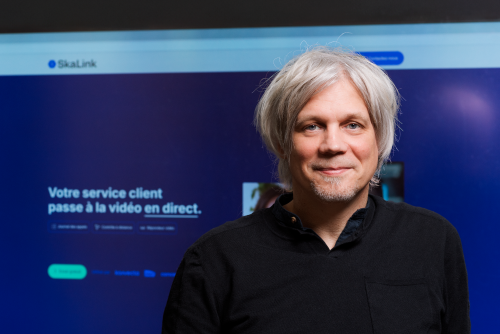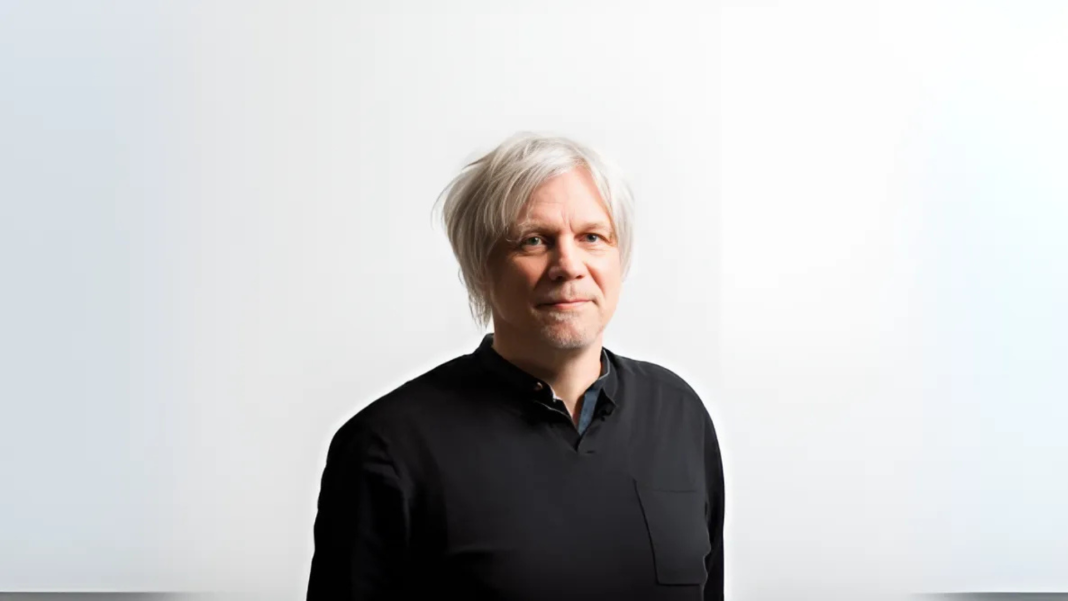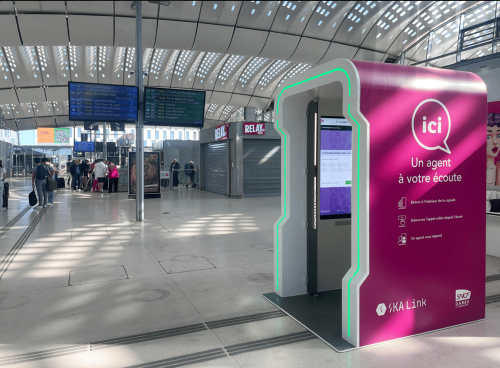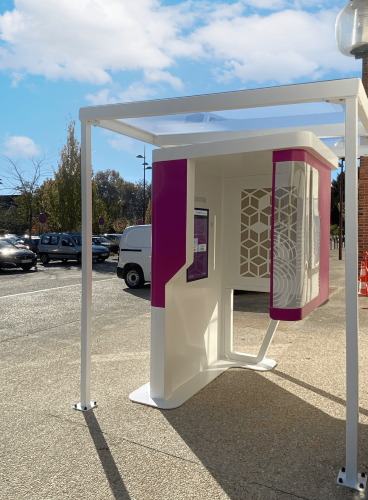With SkaLink, a video connection software between customers and support agents, the Luxembourg-based company iNUI Studio believes it has found its “commercial success.” A milestone that marks its decision to focus on software rather than its AIRxTOUCH contactless screen technology.
“iNUI Studio has chosen to refocus on its DNA: software development“, announced the Luxembourg-based company iNUI Studio in early February 2025. A shift towards software, after having spent the past few years concentrating on its AIRxTOUCH contactless screen technology.
At the heart of this shift is the SkaLink solution. It emerged in the summer of 2024 in the form of capsules installed in France at the Montpellier high-speed train station and later at the Nogent-sur-Seine station—sort of 2.0 phone booths that allow users to connect via live video with SNCF agents.
SkaLink’s ambition is to facilitate customer support while maintaining human interactions for tasks such as purchasing or exchanging tickets, guiding users in stations, or providing train information. And the solution has found its audience: according to figures provided by iNUI Studio, SNCF agents have handled more than 2,000 video calls with a user satisfaction rate of 80.2%.
The Success of SkaLink
“SkaLink has been a real success: people are speaking very positively about it on social media, and the fact that we have been in production with SNCF gives us great credibility“, enthuses iNUI Studio’s founder and CEO, Olivier Raulot. “I believe that with SkaLink, we truly have our commercial success“.
A success that could mark the culmination of a journey filled with promising inventions, more critical than commercial successes, and strategic shifts. Since its inception, iNUI Studio has been searching for its identity, wavering between being a hardware creator and a software developer.
In the 2000s, Olivier Raulot was head of Microsoft’s development division for Belgium and Luxembourg at Getronics, a Dutch ICT services company. Through his work with Microsoft, he discovered early prototypes of touch tables and gesture and voice recognition technologies, which served as an inspiration.

The First Software Dedicated to Touch Tables
At the end of 2010, with two former colleagues from Getronics, Olivier Raulot founded iNUI Studio, a company specializing in natural user interfaces (hence the name “iNUI”). These are computing interfaces that do not require a keyboard or mouse but instead use “natural” inputs such as touch, movement, and voice.
The initial idea was to develop software dedicated to natural interfaces—that is, the “software layer” enabling the use of existing hardware. Initially, iNUI Studio developed banking applications for large touch tables used by institutions such as Raiffeisen, Spuerkeess, BCV in Switzerland, and Caisse d’Épargne in France.
With this software offering, the company quickly surpassed one million euros in revenue. “It was very profitable; we should have probably sold the company at that point”, recalls Olivier Raulot. But an opportunity arose to develop a hardware technology.
The Emergence of AIRxTOUCH Contactless Screens
This opportunity came from JCDecaux, a leader in urban advertising, in 2014. The company wanted to develop interactive bus shelters that would avoid using touchscreens, which were not well-suited for public spaces due to hygiene concerns. Instead, they sought to use gesture-recognition cameras for remote interaction.
However, existing cameras performed poorly outdoors due to sunlight. iNUI Studio then decided to develop its own technology based on 2D cameras that better resisted sunlight disturbances. This led to the creation of the first AIRxTOUCH contactless screen prototype. “We ran several campaigns with JCDecaux, and it was quite a success“, says Olivier Raulot.
The iNUI Studio team then targeted store windows, envisioning a way for passersby to interact with a screen behind the glass—even when the store was closed. The company equipped store windows for IKEA, Globus in Switzerland, and even PMU bars in Lyon, allowing customers to continue betting while smoking outside. “It wasn’t an enormous commercial success; we would have needed to sell 10,000 units instead of 150“, observes Olivier Raulot.
Investing Everything in Hardware
Yet, AIRxTOUCH represented a true innovation, and the iNUI Studio team was determined to refine the technology to increase sales. “Perhaps it was a mistake because we had a real cash cow with our touch table software”, reflects Olivier Raulot. “But we decided to invest all that revenue into developing the AIRxTOUCH technology because we strongly believed in it—until COVID hit“.
Indeed, with the COVID-19 pandemic, AIRxTOUCH suddenly “made perfect sense” for obvious hygiene reasons. iNUI Studio adapted its technology to develop contactless ordering kiosks. Launched at the end of 2021, they quickly gained traction, especially in airports in Nordic countries and across 60 locations of the Canadian restaurant chain St-Hubert.
“We achieved a level of precision, responsiveness, and ease of use that is unmatched“
“We achieved a level of precision, responsiveness, and ease of use that is unmatched“, says Olivier Raulot. “Globally, we are the only ones who have done this—proven by the fact that only our screens have been deployed at scale in environments where flawless performance is essential“.
Despite this, sales plummeted in 2023. “Talking about hygiene had become negative—people didn’t want to hear about COVID anymore“, recalls Olivier Raulot. “What was once an advantage became a drawback“.
Returning to Software
Sensing the shifting tides, iNUI Studio responded to a 2022 SNCF call for projects aimed at rehumanizing train stations and addressing staffing shortages. The idea was to reuse AIRxTOUCH technology in train stations but in a much more promising vertical—not just selling hardware but also software.
With this project, iNUI Studio not only integrated its AIRxTOUCH technology into the SkaLink capsules but also developed software to optimize support team efficiency through advanced features such as call queue management, call transfers, video recording, screen sharing, remote control, video messaging, and real-time statistics.
Encouraged by its success with SNCF, iNUI Studio then developed a full-fledged platform designed for public services and businesses across multiple sectors, including transportation, banking and insurance (claims reporting), telecom operators (internet box support), retail (after-sales service), and tourism (visitor information). One key benefit is that by enabling immediate visual diagnostics, the platform reduces operational costs by eliminating unnecessary in-person visits.
The Passion for Hardware vs. The Profitability of Software
And the company is now fully committed to software. Clients can choose how to deploy it—whether through a call button or QR code on a website, using a touchscreen tablet or a contactless screen, purchased from iNUI Studio or another supplier. The core principle remains simplicity: the solution is operational within 15 minutes, without requiring phone numbers or app installations.
“Software margins are much more attractive“
Why this shift to software? Simply put, “software margins are much more attractive“, explains Olivier Raulot. For example, at St-Hubert, although the chain purchased contactless kiosks from iNUI Studio, they developed their own software. “It’s frustrating because we do the hardest work but earn less“, he notes. In contrast, software development is less capital-intensive and lower-risk than hardware.
Yet, the previous pivot to hardware had its own logic. “It’s more impactful to transform the world with hardware than to just create software“, admits Olivier Raulot. But it’s also far more complex, requiring stock management and cash flow, making it less appealing to investors. “After five years on this project, it was crucial to find a path to profitability. And the opportunity emerged through software“.
€1.5 Million Fundraising Round
Following a €1.5 million fundraising round to support its launch in March and its development, iNUI Studio is determined to continue improving its SkaLink product. Planned enhancements include an AI-powered instant translation service and a web callback system, allowing users to leave a video message outside business hours and receive a call back from an agent the next day.
And the evolution doesn’t stop there—starting with SNCF. “SNCF’s plan is to install capsules in major train stations and screens with dynamic QR codes in smaller stations”, explains Olivier Raulot. “When people have an issue, they scan the call QR code, and immediately—without needing to install an app—they can connect with a remote agent through our software”.
Moreover, Olivier Raulot envisions his software being used in an untapped market: order-taking. “Why not imagine having screens with a call button in restaurants for placing orders, with a remote counter shared by all locations of a restaurant chain? You press the button, get connected, and place your order”. Discussions are reportedly underway with various restaurant chains.
One Does Not Exclude the Other
Banks are also showing interest, with the idea of installing capsules in supermarkets, allowing customers to connect with an advisor via video call at any time. These would be mini-branches of just 2 square meters—significantly cheaper than a traditional branch.
At the same time, despite this shift toward software, hardware has not been forgotten. iNUI Studio still aims to improve its AIRxTOUCH technology to make it fully usable outdoors, even in direct sunlight. The company also continues to dream of making it profitable by licensing the technology to a major player who could produce AIRxTOUCH screens on a large scale. “We have been in discussions with the headquarters of Samsung and LG for five years, but nothing has come of it yet“, notes Olivier Raulot, who seems increasingly doubtful.
“Even though we have pivoted twice, there is a clear continuity in our journey“
Whether hardware or software, iNUI Studio appears determined to pursue both avenues. “We still remain true to the company’s original focus on natural user interfaces“, Olivier Raulot points out. “We started with touch, then moved to gesture recognition, and now we are shifting towards voice. Even though we have pivoted twice, there is a clear continuity in our journey“.

This article was published in the 5th edition of Forbes Luxembourg magazine.
Read more articles:
Why Do Investors Continue to Choose Luxembourg?



